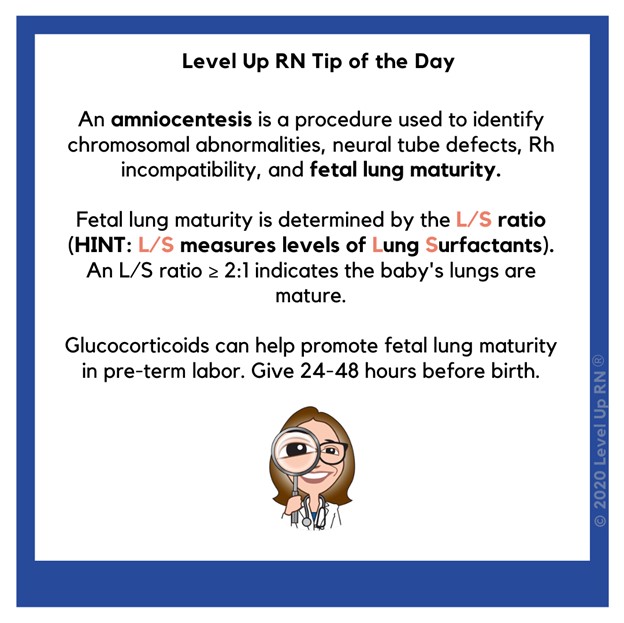A nurse is using vibroacoustic stimulation (VAS) to stimulate fetal movement during a nonstress test (NST).
What action should the nurse take when applying VAS?
Place the device over the fetal back for 3 seconds
Hold the device firmly against the maternal abdomen for 10 seconds
Move the device around the maternal abdomen until fetal movement is detected
Apply the device intermittently over the fundus for 15 seconds
The Correct Answer is A
Place the device over the fetal back for 3 seconds. This is because vibroacoustic stimulation (VAS) is the application of a vibratory sound stimulus to the abdomen of a pregnant woman to induce fetal heart rate (FHR) accelerations. The presence of FHR accelerations reliably predicts the absence of fetal metabolic acidemia. VAS is typically used during a nonstress test (NST) to assess fetal well-being. The device should be placed over the fetal back for 3 seconds, as this is the optimal duration and location to elicit a fetal response.
Choice B is wrong because holding the device firmly against the maternal abdomen for 10 seconds may be too long and too strong for the fetus, and may cause discomfort or distress.
Choice C is wrong because moving the device around the maternal abdomen until fetal movement is detected may not be effective or efficient, as the device may not reach the optimal location or duration to stimulate the fetus.
Choice D is wrong because applying the device intermittently over the fundus for 15 seconds may not target the fetal auditory system, which is located near the fetal back, and may also be too long and too strong for the fetus.
Normal ranges for FHR are between 110 and 160 beats per minute, and FHR accelerations are defined as an increase of at least 15 beats per minute above baseline for at least 15 seconds.
Nursing Test Bank
Naxlex Comprehensive Predictor Exams
Related Questions
Correct Answer is B
Explanation
Lecithin/sphingomyelin (L/S) ratio.
This is a test that measures the amount of two phospholipids in the amniotic fluid that are important for the production of surfactant, a substance that helps the lungs expand and prevents them from collapsing.A higher L/S ratio indicates more surfactant and greater fetal lung maturity.The normal range for L/S ratio is 2:1 or higher at term.

Choice A is wrong because alpha-fetoprotein (AFP) is a protein produced by the fetus that can be measured in the amniotic fluid or maternal blood.It is used to screen for neural tube defects and other abnormalities, not for fetal lung maturity.
Choice C is wrong because Kleihauer-Betke test is a blood test that detects fetal red blood cells in the maternal circulation.It is used to diagnose fetomaternal hemorrhage, a condition where fetal blood leaks into the mother’s blood, not for fetal lung maturity.
Choice D is wrong because indirect Coombs’ test is a blood test that detects antibodies in the mother’s blood that may attack the fetal red blood cells.It is used to screen for Rh incompatibility or other blood group sensitization, not for fetal lung maturity.
Correct Answer is C
Explanation
Category III.This category of FHR tracing represents an abnormal pattern that is predictive of fetal acidemia and requires prompt evaluation and intervention.A category III pattern is defined by any of the following criteria:
• Absent baseline FHR variability and any of the following:
➤ Recurrent late decelerations
➤ Recurrent variable decelerations
➤ Bradycardia
• Sinusoidal pattern
Choice A is wrong because category I is a normal pattern that is predictive of normal fetal acid-base balance at the time of observation.A category I pattern is defined by all of the following criteria:
• Baseline rate of 110 to 160 bpm
• Moderate baseline FHR variability
• No late or variable decelerations
• Early decelerations may be present or absent
• Accelerations may be present or absent
Choice B is wrong because category II is an indeterminate pattern that is not predictive of abnormal fetal acid-base balance but requires continued surveillance and reevaluation.A category II pattern includes all FHR tracings that are not category I or III.
Choice D is wrong because there is no category IV in the NICHD classification system for FHR tracings.

Whether you are a student looking to ace your exams or a practicing nurse seeking to enhance your expertise , our nursing education contents will empower you with the confidence and competence to make a difference in the lives of patients and become a respected leader in the healthcare field.
Visit Naxlex, invest in your future and unlock endless possibilities with our unparalleled nursing education contents today
Report Wrong Answer on the Current Question
Do you disagree with the answer? If yes, what is your expected answer? Explain.
Kindly be descriptive with the issue you are facing.
